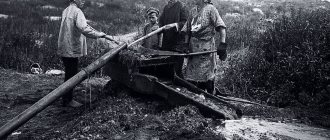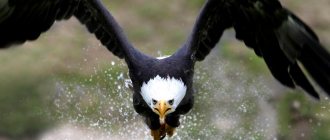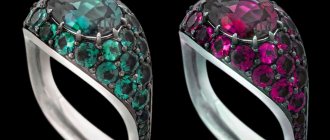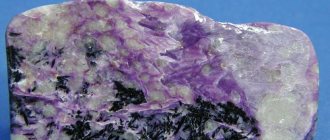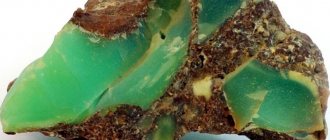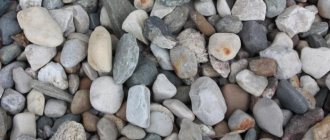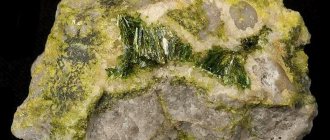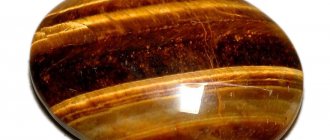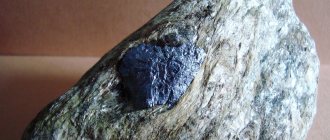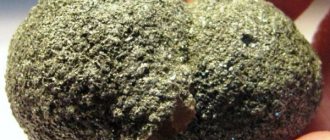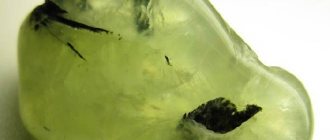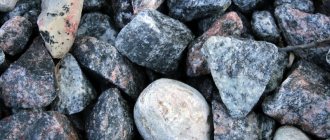Antimonite formula
Sb2S8
Contents Chemical composition Crystallographic characteristics Form of occurrence in nature Physical properties Chemical properties Diagnostic features Origin of the mineral Deposits Practical application Buy
Chemical composition
The mineral stibnite consists of Sb - 71.4%, S - 28.6%. and a small amount of impurities. Among the impurities, As, Ag and Au are sometimes identified. The last two elements appear to be present as mechanically connected connections. Native gold was repeatedly established in the mass of stibnite in polished sections under a microscope.
The healing effect of the mineral
Traditional healers use the properties of stibnite to solve the following problems:
- pimply skin;
- conjunctivitis;
- arthritis, arthrosis;
- fatigue, loss of strength;
- nervousness, anxious sleep, depression.
Mineral powder is also used to treat eye diseases, burns, and stop uterine or nosebleeds.
Antimony preparations make eyebrows and eyelashes thicker and “force” them to grow faster.
Crystallographic characteristics
System Antimonite crystallizes in the orthorhombic system; rhombodipyramidal c. With. 3L23PC. Etc. gr. Рbpt (D162h). a0 = 11.20; b0 = 11.28, c0 = 3.83
Symmetry class. Rhombic-bipyramidal -2/m 2/m 2/m. Axle ratio. 0.933: 1: 0.340.
Crystal structure
The crystal structure is represented by ribbons of closely bound Sb and S ions, elongated parallel to the axis, consisting of zigzag chains - Sb-S-Sb-S-. Five sulfur anions participate in the environment of antimony, so that the coordination polyhedron turns out to be a semi-octahedron; the place of the sixth atom of the octahedron is occupied by a lone electron pair of incompletely valent antimony. The semi-octahedrons are connected through common edges of square bases into layers and have their vertices facing the middle of the ribbon, where two layers converge and, connecting through inclined edges, form one layer, represented in the ribbons. Lone pairs of electrons protrude from the outer surface of the ribbons into the interribbon space; therefore, the bonds between individual ribbons are weaker than between ions inside the ribbons. All this, naturally, affects not only the shape of the crystals, but also such properties as cleavage, hardness, fragility and fusibility.
Main forms:
Crystal shape. Of the numerous established faces, the following combinations are most typical: prisms {110}, pinacoid {010} and pyramids {111}, {113}, {121}, etc. Prismatic, columnar, needle-shaped, with vertical hatching, often curved.
Antimonite form found in nature
The appearance of crystals.
From coarse to fine prismatic along [001], the crystals are streaked or furrowed along [001]. The most common forms: bomnspeo t. Often curved and twisted. Common in entangled aggregates of needle-shaped crystals; also in radial groups, columnar masses, granular to extremely fine-grained. Often, especially for large specimens, there is curvature and even twisting. Doubles. Rare, a) Twin plane {130}; 6) twin plane {310}, doubtful; c) twin plane {120}.
Aggregates.
Stibnite is also found in the form of solid granular, often radial, less often matted fibrous aggregates and in the form of disseminated grains in the quartz mass. Cast iron-like solid dense fine-grained aggregates are also known.
Antimonite crystal. Bright metallic shine, shading on the edges
Physical properties of stibnite
Optical
- Color. Lead-gray, often with mottled tarnish
- Trait. Gray, black, dark lead gray.
- Shine. Metallic, strong on cleavage planes
- Low tide. Dark bluish tarnish is often observed on crystals, sometimes iridescent.
- Transparency. Opaque except under red light and infrared.
Mechanical
- Hardness. 2
- Fragile. Lightly cut with a knife.
- Stibnite crystals easily bend along [100] or twist around [001]. Slip planes 8 s T {010}, / [001 }
- Density. 4.63 ±0.02; 4.63 (calculated)
- Cleavage along {010} is perfect; by {100}, {110} imperfect.); Coarse transverse shading is observed on the cleavage planes.
Stibnite diagnostic signs
Similar minerals . Bismuthinite, pyrolusite, galena and others.
Diagnostic signs. In aggregates, the color and mechanical properties of stibnite are similar to many sulfoantimonites (boulangerite, jamesonite, etc.) and especially to bismuthin. Its characteristic distinctive features are: perfect cleavage along the elongation of columnar individuals and transverse twinning streaking in the cleavage planes. In fine-grained and cryptocrystalline masses, as well as in small inclusions from all minerals similar to it, it is unmistakably determined by reaction with KOH. A drop of this reagent placed on a mineral vigorously decomposes it and soon becomes yellow, then orange; After erasing the drop, a red stain remains.
Satellites. It is found with realgar, orpiment, galena, lead sulfoantimonites, marcasite, pyrite, cinnabar, calcite, ankerite, barite, chalcedony quartz, native gold, siderite.
Story
The name comes from the Latin antimonium - antimony .
The history of the mineral is rich:
- In Ancient Egypt, they were used to treat eye ailments, and ladies “shaded” their eyebrows and eyelashes.
- Medieval alchemists, led by Vasily Valentine, tried to extract gold from shiny ore.
- At the end of the 18th century, the chemist Lavoisier added the term Antimoine to the mineralogical register.
- The first to describe its properties in detail was the Frenchman Francois Bedan, but proposed to call it stibine (1832). However, after 13 years the mineral again became stibnite.
The term "antimonite" has enriched philology. The expression “to breed antimony” means a long rant: eyebrow antimony was ground with oil for hours. According to another version, medieval monks spared no time in discussing the possibilities of stibnite.
The French term means "against the monks". The abbot of one of the monasteries noticed that the pigs from the “subsidiary farm” quickly grew fat on ore powder. And he decided to “feed” the emaciated brethren. However, its use has become fatal to people.
The terms "antimony luster" and "stibnite" are used in relation to stibnite. But these are not varieties of the mineral, but synonymous names.
Antimonite origin and location
Stibnite is formed at very low temperatures (epithermal). Mostly, stibnite is found in hydrothermal deposits, forming at the lowest temperatures and forming independent veins and sheet-like deposits together with quartz. Often associated with it are cinnabar, fluorite, quartz, calcite, kaolinite, barite, and sometimes pyrite and gold. As a companion, it is almost constantly observed in deposits of cinnabar, realgar and orpiment, and occasionally in deposits of lead, zinc and other metals. In negligible quantities it is sometimes observed in sublimation products during volcanic eruptions. In the oxidation zone, it decomposes relatively easily, turning into various yellow, sometimes brown, antimony oxides (valentinite, servanttite, senarmontite, kermesite, etc.).
Artificial production of stibnite
It is obtained in good crystals by passing H2S and HCl over Sb2O3 at 450°. It is easily formed by fusing the constituent parts, heating amorphous red Sb2S3 above 250°, and by direct reaction of Sb and S under high pressure.
Changes . Into kermesite, and with complete oxidation - to servantite, stibikonig, senarmontite, valentinite. A change was also observed with the formation of cinnabar, realgar and sulfur. Described as an alteration product of senarmontite.
Industrial use
For many years, the industrial use of the metal was limited to printing - printing presses are still made from lead alloys with the addition of antimony. Subsequently, the field of application expanded to mechanical engineering.
The addition of antimony to lead and tin alloys increases their hardness, and the area of application is bearing units, batteries, and the sheath of large-diameter power cables.
The development of electrical engineering and electronics has opened up another direction for the practical use of the properties of this metal. Today, there are about 200 alloys that contain the chemical element number 51. In some, doping with this chemical element allows one to obtain unique magnetic properties; in others, one can obtain a variety of semiconductors with a wide range of conductivity.
Antimonite deposits
Stibnite is the most important ore of antimony, and although widespread, large deposits are rare. A typical mineral of low-temperature and hydrothermal veins or replacement deposits and hot spring deposits.
Types of industrial deposits
Among the industrial deposits of antimony, the following are distinguished: 1) plutonogenic hydrothermal, 2) volcanogenic hydrothermal, 3) stratiform.
Plutonogenic hydrothermal deposits
Represented by two-ore formations: quartz-antimonite monometallic antimony (sometimes with gold) ores and complex ores containing Sb, As, Te, Au, Ag, W, Cu, Pb and Zn
Antimonite with quartz. Photos from the Kadamjay field
Deposits of the quartz-antimonite formation
In Russia they are known in Yakutia (Saryly) and the Krasnoyarsk Territory (Razdolninskoye, Udereyskoye), abroad - in Czechoslovakia (Peznnok), South Africa (Gravellot), Turkey (Ezdemir), Thailand (Ratburi), Australia (BlueSpec), Bolivia (Chilkobiya ) and Mexico (Tejocates). These deposits occur in rocks of aluminosilicate composition - sandstones, shales, metamorphic shales and gneisses. They are confined to regional faults, zones of crushing and fracturing. The shape of ore bodies is predominantly vein. Systems of en-echelon veins can be traced for kilometers and even tens of kilometers along strike and to a depth of 1000-1200 m, without significantly changing their mineral composition. The dimensions of individual ore veins in length and dip are up to 300-500 m; their thickness varies from 0.1 to 5-6 m, sometimes in swellings up to 20 m, the average is 1-2 m. Rich stibnite ores contain antimony from 2-3 to 40%, on average 10%.
The mineral composition is quite simple.
The main ore mineral is stibnite, the vein mineral is quartz; minor ones are berthierite, gundmundite, pyrite, arsenopyrite, as well as chlorite, sericite and siderite. Mineral formation occurs in two stages: early - quartz and late - sulfide. Hydrothermal changes in the host rocks at an early stage are expressed by silicification, chloritization, and pyritization. Sarylakh. Located in Yakutia. The ore-bearing stratum is composed of steeply dipping sandstones and siltstones of the Upper Triassic. Igneous rocks, represented by a stock of quartz diorite-porphyrites, belong to the Late Jurassic complex of small intrusions. The deposit controls a deep northwest-trending fault, which divides areas of intense linear folding of weak dislocations. The ore body is represented by a quartz-stibnite vein, confined to the central part of the crushing zone with a north-western strike, up to 15-18 m thick. The length of the ore vein is hundreds of meters along strike with an increase in thickness in the bulges that fall on the sandstone horizons. The main ore mineral is stibnite , the vein mineral is quartz; minor pyrite, arsenopyrite. Massive ore textures are developed in the hanging side of the vein, nested, veined and disseminated in its footwall and in areas of pinching out. In the near-surface areas, stibnite is partially oxidized and replaced by senarmontite and valentinite. The near-ore changes are expressed in silicification, sericitization and pyritization.
Deposits of complex formations, ores
Plutonogenic hydrothermal deposits of these formations include deposits with ores: scheelite-gold-antimonite (Vosi in China), wolframite-stibnite-cinnabar (Barun-Shiveya in Transbaikalia, Xi'an in China), stibnite-argentite-lenite-sphalerite (Sunshine in the USA ) and cassiterite-antimonite (Sary-Bulak in Central Asia). These deposits are of medium and small scale. The host rocks are represented by terrigenous sediments, sometimes carbonate, and granitoids. The host structures are faults, cracks and, less commonly, folds. The shape of the ore bodies is vein, but stockwork, pipe-shaped and conformable lens-shaped deposits are also found. Along the strike they can be traced for tens - a few hundred meters, along the dip to 250-300 m with a thickness of 0.1 to 2-3 m.
The mineral composition is quite complex. The main ore mineral is stibnite, minor ones are berthierite, goodmundite, arsenopyrite, pyrite, ferberite, scheelite, chalcopyrite, galena, sphalerite, native antimony, jamesonite, falcmanite and boulangerite, the main vein mineral is quartz, and sometimes carbonates. Ore deposition occurred in the range of 300–200 °C in two stages: early - berthierite-stibnite and late scheelite-ferberite-stimonite. Vertical zoning is clearly expressed: complex ores containing chalcedony-like quartz, ferberite scheelite, cinnabar and stibnite are found in the middle and upper horizons; at depth they are replaced by simpler quartz-stibnite ores.
Volcanogenic hydrothermal deposits
They are known abroad in the SRR (Baya Mare, Baya Sprye), Turkey (Tökgör, Akdashanaya Dere), Algeria (Hamman N'Bail, Hammi-mat) and the USA (Yellow Pine). They are found in areas of young and modern volcanism, as well as in areas where thermal springs develop. Associated with andesitic and liparitic complexes. Often associated with rocks of vent and subvolcanic facies, but also found among calcareous-clay deposits. The ore-bearing structures are structures of volcanic origin - necks, ring and radial cracks, as well as tectonic zones of crushing and fracturing. Ore bodies are represented by branching veins, stockworks, pipe-shaped bodies, consonant lenticular and complex mushroom-shaped deposits. Their dimensions are small, the first tens of meters in length along the strike, up to 200-250 m along the dip with a thickness of 0.1 to 10 m. Antimony and complex ores - arsenic-antimony, antimony-silver and antimony-tin. The main ore mineral is stibnite , sometimes oxychlorides of antimony and lead (nadorite) or simple oxides - servanttite, minor ones - livingstonite, fahlores, galena and sphalerite; veins - chalcedony-like quartz, sericite and carbonates. Servantite, stibioconite, and limonite are developed in the oxidation zone. Hydrothermal alteration of the host rocks consisted of silicification and kaolinization. Mineral formation occurred in one fleeting stage.
Antimonite. Columnar unit
Stratiform deposits
They are known in Central Asia (Kadamdzhai, Dzhizhikrut, Terek), abroad - in China (Xinhuanshan), Belarus (Rybnovo), Italy (Peretta) and Mexico (San Jose). The deposits were formed in miogeosynclinal zones and on platforms; are confined to carbonate deposits overlain by shale. Gently folded structures, brachyanticlinal and chest folds are characteristic. Folding can be complicated by thrusts and steep faults, which acted as ore supply channels. In gentle, often hinged sections of folds, thick (up to 200 m) interformational deposits of silicified limestones—jasperoids, usually brecciated—are formed. They contain most of the ore bodies of sheet-like or lens-shaped form, gravitating towards the upper part of the section, under shale screens. Ore deposits extending along strike for many hundreds of meters, sometimes a few kilometers, can be traced along a dip of up to 1000 m with a thickness of several meters to 40-50 m. Stratiform deposits belong to the quartz-fluorite-stibnite formation. Antimony and antimony-mercury ores. The antimony content in them is 1-12%, on average 1.5-3%. The main minerals are stibnite and quartz; minor ones are cinnabar, marcasite, pyrite, arsenopyrite, boulangerite, jamesonite, sphalerite, chalcopyrite, orpiment and realgar, as well as calcite, fluorite, sericite and barite. Hydrothermal alteration of the host rocks belongs to the pre-ore stage and is expressed in silicification, carbonatization and pyritization. Ore deposition occurred in two, and in some deposits, three stages. In the early stage, at a temperature of 205–105 °C, the bulk of stibnite and cementation quartz was formed. In the late stage, at a temperature of 100-70 °C, barite and calcite were released, accompanied by the deposition of realgar, orpiment and a small amount of stibnite.
Kadamjay. Located in Central Asia. The area is composed of massive and coarsely layered Lower Carboniferous carbonate rocks, as well as Middle Carboniferous and clayey shales, overlain by Devonian and Silurian terrigenous sediments. There are dikes of diabase porphyrites of Late Hercynian age. The deposit is confined to the western closure of the Aktash sublatitudinal anticline, the core of which is composed of Lower Carboniferous limestones, and the wings of Middle Carboniferous shales. Interformational sheet-like deposits of ore-bearing hornfels and jasperoids breccias are confined to the arches of small chest brachyanticlines complicating the pericline of the Aktash fold. Ore-bearing breccias are also known along faults that complicate folding. Interformational breccias reach their maximum thickness (up to 25–30 m) in the arches of anticlines; on their wings it decreases. Breccias consist of angular fragments (0.2–2 cm) of silicified limestone and shales cemented by quartz and stibnite. The distribution of mineralization in breccias is uneven; Rich conformable stibnite deposits are localized under a shale screen and are confined to anticlines with a small bend radius, complicated by ruptures. Lenticular and vein-shaped ore bodies are found at the intersections of fractures. The main ore mineral is stibnite , minor ones are pyrite, marcasite, realgar, orpiment, chalcopyrite, sphalerite and galena; The main vein is quartz, the secondary veins are fluorite, calcite, barite, dickite and sericite. In the oxidation zone, kermesite, valentinite, senarmontite, hydroservantite, stibioconite and aragonite are widely developed.
The textures of the ores are massive, brecciated, disseminated and banded, less often veined, combed, cockade and drusy; structures - coarse-crystalline, radial-radiant, fine-grained and metacolloidal. Hypogenic mineral formation occurred in three stages. In the first stage, metasomatic silicification occurred with the formation of hornfels in shales and jasperoids in limestones; it was accompanied by minor sericitization and the development of rare dissemination of pyrite, chalcopyrite, galena and sphalerite. In the second stage, breccias of silicified rocks were cemented with quartz and stibnite, calcite and fluorite. In the third stage, veinlets of calcite-realgar-orpiment composition were formed. The Kadamjaya ores, judging by the presence of breccia textures and metacolloidal structures, were formed at shallow to moderate depths.
Antimonite practical application
An important raw material for the production of antimony.
Stibnite ores are the main source of antimony, which has a variety of uses. It is mainly used for the production of alloys with antifriction properties (babbitts for bearings). Alloys with lead and zinc are used to produce the so-called “printing metal”, hard shot, parts of pumps, taps, etc. Antimony compounds are also used in the rubber industry (for the purpose of rubber vulcanization), textile production (for impregnating fabrics), glass business, medicine and a number of other industries.
Where is it used?
The main consumer of mineral raw materials is industry:
- Antimony is extracted from the ore, which is used as a component of alloys for bearings and batteries.
- Without antimony, the vulcanization of rubber, the production of ceramics, and technical fabrics are impossible.
- In demand in the electrical, paint and varnish, glass, and defense industries.
- For perfumers it is important as a source of dyes for eyebrows and eyelashes, eyeliner.
The most famous use of antimony is as sulfur in matches.
Antimonite stone is not considered a jewelry stone. It is classified as ornamental or collectible.
